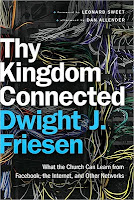After debriefing last class's "historical world" field trip, we agreed that "GEOGRAPHY MATTERS."
So before beginning our journey through Matthew 1 and 2, we followed up on that theme with a VanDer Laan video which gave a graphic example of how Jesus was intentional in WHERE he taught WHAT , taking the disciples far out of his way (not) just so he could have the right backdrop or object lesson.
The video took us to the "gates of hell" at Caserea Phillip. the video is not online, but a 5-page summary slideshow of it is here.
---
Then we introduced some more symbols, adding to those found on the post for 9/1.
We'll define the new ones that we covered in class below:
#5)Intercalation (Sandwiching)
'Intercalation" is a "sandwiching" technique. where a story/theme is told/repeated at the beginning and ened of a section, suggesting that if a different story appears in between, it too is related thematically. We looked at this outline of Mark 11:
A)CURSING OF FIG FREE
B)CLEANSING OF THE TEMPLE
A)CURSING OF THE FIG TREE
#8) Subversion of Empire:
This picture calls to mind Herod (as a representative and agent of the Roman Empirw)'s Herodian fortress (left) and Jesus' manger (right), as per the "Shadow of Herod" video we watched on, and you can re-watch here). We'll find Jesus subversion of empire as an ongoing theme in Matthew .
#13: Double Paste:
This represents hitting the "CONTROL V" button, "pasting" two scriptures together, or "splicing" two scriptures into one new one. Classic example is Jesus in the temple tantrum.
ISAIAH 56:6-8 + JEREMIAH 7:11=MARK 11:16
#14 Prophecy:
t is helpful to think of prophecy as:
a).not just
fore-telling (predicting the future)
but
forth-telling (telling forth truth)
b)often having multiple applications and fulfillments, to different "contemporary worlds" and across time.
We'll used this diagram to illustrate:
-Who wasI mmanuel?
-Who does "out of Egypt, I have called my son" refer to ?
It's BOTH/AND>>hmmm
#15 : 6 Degrees of Separation:
"A documentary on networks, social and otherwise"
" (part 1):
" (part 1):
Parts 2, 3, 4 , 5, (not 6) are also online
-------------------
Kraybill, in your "Upside Down Kingdom," book, says,
Check out New Testament Social Networks
by clicking here. To see chart below, click it, then click again to enlarge:
---
See also a preview of the book.
-------------------
Kraybill, in your "Upside Down Kingdom," book, says,
"The Kingdom of God is a collectivity--a network of persons....more than a series of
individualized email connectionslinking the King to each subject...[It] infuses the web of relationships, binding King and citizens togeter" -Kraybill (emphases mine)
Check out New Testament Social Networks
by clicking here. To see chart below, click it, then click again to enlarge:
---
See also a preview of the book.
"Thy Kingdom Connected: What the Church Can Learn from Facebook, the Internet, and Other Networks," by Dwight J. Friesen
Do you and I have any surprising common Facebook friends? Click here to find out
_____________
Then we began looking at Matthew 1 and 2, putting some of these symbols to work:
-Jesus geneology (we noted it was the same word as "genesis"),
- not just women,
- but 5 (hmm, remember that number) women,
- and 5 women who had a "shady reputation".
That's no accident; we decided that one way to answer "Who is Jesus in Matthew?" is
"One who includes all types, even outcasts, in his family, Very centered set, and we are only in Chapter 1. (:
Please be familiar with this crucial point, by re-reading Hauer and Young, p, 270, 2nd full paragraph
We had fun as three students assembled a manger scene..
But then we noticed that the text
- Nowhere says there were three
- Nowhere says they were wise
- Nowhere says they were men (:
But most importantly, we know from Luke, they didn't come to the manger when Jesus was a baby, but to the house when he was a child..
We'll continue examinng our Christmas folklore next time (:








 For next class, have read Matthew through chapter 4
For next class, have read Matthew through chapter 4
No comments:
Post a Comment